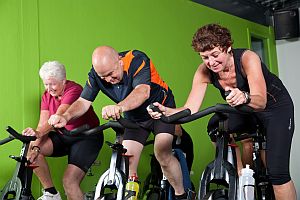Rediscovering Exercise After Years of Being Inactive? Take the SMART Approach

Artists who work with glass or metal know that you should not try to bend or shape the material while it remains cold and brittle. Glass will shatter. Metal will break or quickly show signs of fatigue and damage. Our bodies also need to be warmed up to change. They need the tender, loving care of an artist to reshape them. You are that artist. And sculpting your new body takes time, patience and persistence. And yes, it takes hard work.
You can’t expect your body to react well at the beginning if you ask it to do too much after years of inactivity. Using the following SMART approach to exercise will help you get back into an exercise routine and allow you to reach your goals:
Specific—It’s most effective set exercise goals that are well-defined rather than vague. Say you want to be a trim, 165 pounds of muscle and vibrant energy. This approach to defining your goal not only gives you a specific weight to shoot for, but also describes the feeling you want to go with it.
Measurable—This makes your goal even more concrete and will help you see the progress you’re making in an objective way. Not every approach to measurement uses numbers, but numerical criteria are usually the easiest to work with. This goes for measuring activity as well as measuring the results. For example, a 30-minute, brisk walk is measurable. If you’ve only walked 25 minutes, you know you’re not done. Keeping a journal helps you compare these details later.
Action-oriented—You have to put your dreams into action, and exercise is all about physical movement. But don’t let repetitive exercise become boring. Add different kinds of action. In fact, sports medicine doctors recommend varying the activity between stretching, light endurance, vigorous strength and other types of exercise. This helps to prevent heart attacks, sprains and other maladies from pushing too hard, too fast. It also helps to keep things more interesting.
Realistic—Never let anyone tell you that something cannot be done. By the same token, it never makes sense to ignore reality. If you are not realistic in your goals, you are setting yourself up for failure. Set a few attainable short-term goals when you are starting out in a new exercise program so you are more likely to stick with it as time goes on. It will help give you more confidence and you will be more motivated to set your goals a little higher each time.
Time-related—Set deadlines. This helps to keep you challenged so you keep moving forward. Naturally, any deadline needs to be realistic (see above). You should not expect to be running marathons in one month after a couple of decades of desk work, in-car commutes and armchair quarterbacking.




 Pain and stiffness can significantly reduce your neck’s range of motion. Although a decreased range of motion in your neck may not seem like a major problem, it can actually contribute to a number of unpleasant conditions, including headache, fatigue, irritability and sleep loss. Like any other part of the body, our neck can become stronger and more flexible through exercise. Following are some useful exercises that can help to increase the range of motion in your neck.
Pain and stiffness can significantly reduce your neck’s range of motion. Although a decreased range of motion in your neck may not seem like a major problem, it can actually contribute to a number of unpleasant conditions, including headache, fatigue, irritability and sleep loss. Like any other part of the body, our neck can become stronger and more flexible through exercise. Following are some useful exercises that can help to increase the range of motion in your neck.

